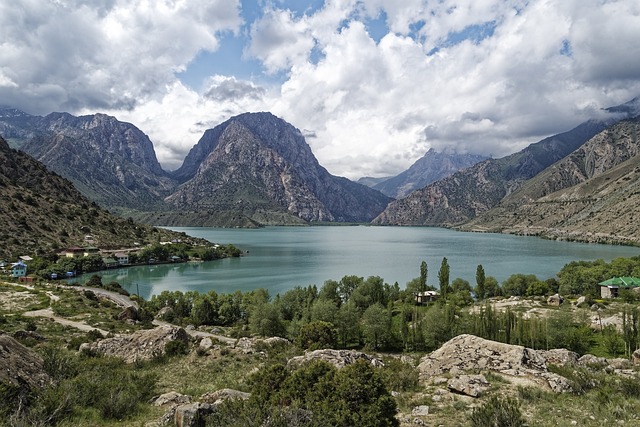Tajikistan / Ҷумҳурии Тоҷикистон / Республика Таджикистан – Let’s explore here

What’s it like in Tajikistan?
Tajikistan is a stunning, almost entirely mountainous, landlocked country in central Asia. The Pamir mountains cover almost all of the country, and most of the country is at least 10,000 feet (3,050 m) above sea level. Communism Peak (Ismoil Somoni Peak), in the north east of the country near the border with Kyrgyzstan, is the country’s highest mountain, at 24,590ft (7,495m) above sea level.
It has a very long, rich and interesting history. Its neighbours include China, Afghanistan, Uzbekistan and Kyrgyzstan.
The population of Tajikistan is around 10 million people (2024), and about one in six of whom live in the capital, Dushanbe.


A bit about the history of Tajikistan
Early History
Tajikistan’s history dates back to ancient times when it was part of the Persian Empire and later the various central Asian empires. The region was influenced by Zoroastrianism, Buddhism and Islam over the centuries. In the medieval period, it was home to important centers of learning and culture, notably the city of Samarkand, in present day Uzbekistan.
Russian and Soviet Era
In the late 19th century, Tajikistan was incorporated into the Russian Empire. Following the Russian Revolution, the region became part of the Soviet Union in 1929 as the Tajik Autonomous Soviet Socialist Republic. Over the next several decades, Tajikistan underwent significant changes as the Soviet government implemented collectivisation, industrialisation, and the promotion of Russian culture, while suppressing local traditions.
Independence
In 1991, following the collapse of the Soviet Union, Tajikistan declared independence. However, the transition was not smooth. A civil war broke out shortly after independence, lasting from 1992 to 1997. The war was fought between the government and various opposition groups, resulting in tens of thousands of deaths and massive displacement. A peace agreement was eventually signed in 1997, leading to relative stability.
Post-Independence Development
After the civil war, Tajikistan experienced a period of recovery, although challenges remain, including poverty, corruption, and the consolidation of power by a single-party system. The government, led by the president since 1992, has focused on maintaining stability, developing the economy, and strengthening ties with Russia and China.
Present Day
Today, Tajikistan is an authoritarian state with limited political freedoms. The economy is heavily dependent on remittances from Tajik workers abroad, especially in Russia. The country remains a key player in central Asia, maintaining strategic relations with neighbouring countries while balancing relations with global powers. However, the nation faces ongoing challenges, including economic difficulties, political repression, and border disputes with Kyrgyzstan and Afghanistan.

Takijistan road trip
On our current road trip through Takijistan we’ll travel from Fergana in Uzbekistan over the Alay mountains down to the capital, Dushanbe. From there, we’ll travel east on to the famous Pamir highway in the Pamir mountains, along the borders of Afghanistan and China before heading north via the Tian Shan mountains into Kyrgyzstan.
Map of our road trip through Takijistan

This is a map of our Takijistani road trip. Our route takes us from Patar – Dushanbe – Nurek reservoir – Khorog – Murghab – Lake Karakul
What’s it like to drive in Tajikistan?
They drive on the right hand side of the road in Tajikistan. In the main, roads are quite poor, however many are unsurfaced dirt tracks. Driving standards are also quite poor.
Do you require an international driving permit in Tajikistan?
We’ve created a dedicated page to driving abroad, which answers this question, and more, which you might find helpful.
Can you use your UK driving license when driving through Tajikistan?
We’ve created a dedicated page to driving abroad, which answers this question, and more, which you might find helpful.
Do I need a carnet de passages to drive in Tajikistan?
We’ve created a dedicated page to driving abroad, which answers this question, and more, which you might find helpful.
What currency do they use in Tajikistan?
In Tajikistan they use the Tajikistani somoni. Cash is widely used. The use of credit / debit cards is not widely accepted outside of the capital, Dushanbe. Travellers cheques are not accepted at banks. There are few ATMs in cities and none in towns. Dollars can be accepted for many purchases.
You should make yourself aware of the amount that your bank charges you for using credit and debit cards abroad. Often credit cards are cheaper for purchasing items directly, and for withdrawing cash from ATMs.
What language do they speak in Tajikistan?
They speak Russian and Tajik in Tajikistan. English is not widely spoken outside of the capital.
What time zone is Tajikistan in?
Remember, when you’re planning your next trip to take a look at what time zone it’s in.
Do I need a visa to visit Tajikistan?
We’ve created a dedicated, more comprehensive page on visas, which you should find helpful. Check it out!
Is wild camping legal in Tajikistan?
Yes, wild camping is fine in Tajikistan.
What plug / socket type do they use in Tajikistan?
In Tajikistan they use plug / socket types C and F.


Health issues in Takijistan
Is it safe to drink water in Tajikistan?
No, it is not safe to drink tap water in Tajikistan. Bottled water is readily available throughout the country.
What vaccinations are required for Tajikistan?
This NHS website is kept up to date with all relevant information on vaccinations in Tajikistan.
Phones in Tajikistan
What is the country calling code for Tajikistan?
The country calling code for Tajikistan is +992
What are the emergency phone numbers in Tajikistan?
- The emergency number for police in Tajikistan is: 112 / 102
- In Tajikistan, the emergency number for ambulance is: 112 / 103
- The emergency number for fire in Tajikistan is: 112 / 101
If you’ve got some useful info that you’d like to share, let us know!
And don’t forget to check out all the other pictures!
